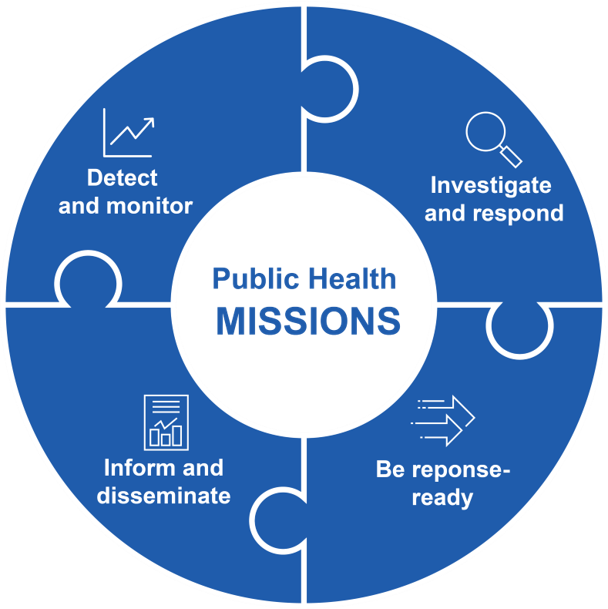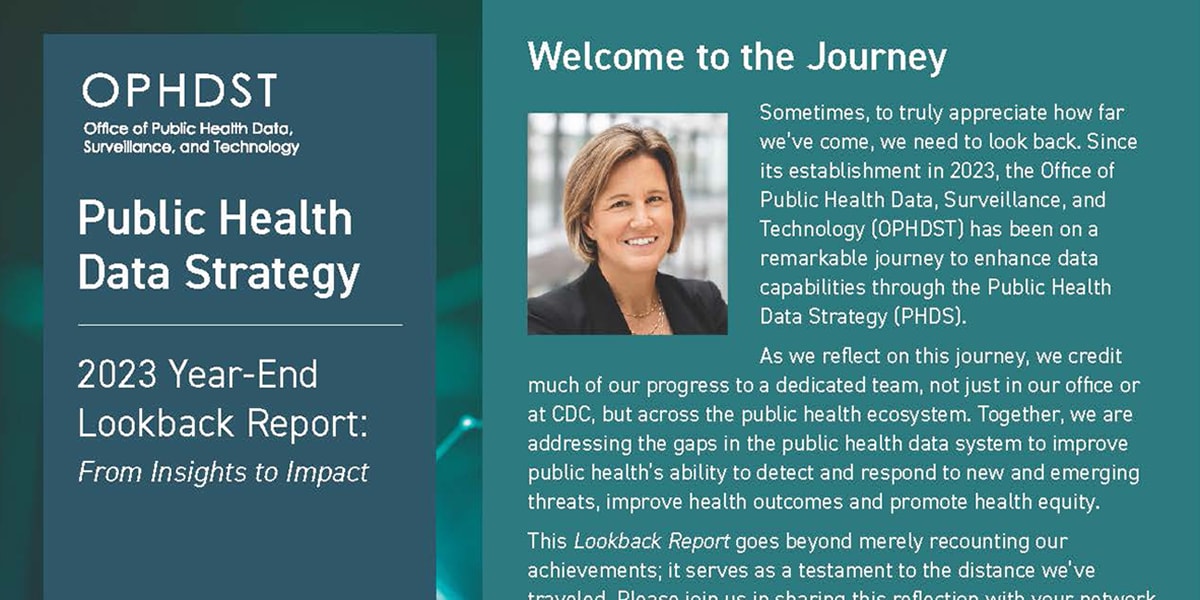The Public Health Data Strategy
Updated April 11, 2024
The PHDS is CDC’s mission-focused, goal-driven, two-year plan providing accountability for data, technology, policy and administrative actions necessary to meet public health data goals. Its measurable milestones address challenges in data exchange between healthcare organizations and public health authorities and between state, tribal, local, territorial and federal public health authorities.
The Public Health Data Strategy (PHDS) provides a way for public health partners, healthcare organizations and the public to understand what is being done, and the progress being made:
- To address gaps in public health data.
- To reduce the complexity of data exchange.
- To help the nation promote health equity.
- To provide timely and actionable data.
- To improve health outcomes for all.
The plan consists of milestones for 2024 and 2025 for each of the four public health data goals.
- Goal 1: Strengthen the core of public health data.
- Goal 2: Accelerate access to analytic and automated solutions to support public health investigations and advance health equity.
- Goal 3: Visualize and share insights to inform public health action.
- Goal 4: Advance more open and interoperable public health data.
These ambitious milestones:
- Define near-term public health data goals, outcomes and measures of success.
- Ensure the nation’s public health ecosystem is response-ready, able to quickly and effectively address new threats.
- Deliver a future-state vision that enables faster, more complete and more secure exchange of high-quality critical core data sources between health care and public health.

The PHDS supports CDC in building long-term accountability for critical core data sources including case, laboratory, emergency department visits, vital statistics, immunization, healthcare capacity and wastewater data.
Enhancement of these data sources and technologies advances public health core capabilities at all levels of government, strengthening public health digital infrastructure and situational awareness in support of the American Pandemic Preparedness Plan and improving risk awareness and threat detection in alignment with Goal 1 of the National Biodefense Strategy.
These are the data and technology goals of the PHDS to advance four core public health missions which will equitably improve health outcomes:
- Address the imperative of the CDC Moving Forward effort to consistently deliver public health information and guidance to partners, including the public, in near real-time.
- Align data modernization efforts at all levels of public health and across partners, measuring success through concrete and measurable two-year milestones.
- Build on lessons learned from recent public health threats such as COVID-19 and mpox to be more response ready.
- Create accountability for public health data within CDC’s Office of Public Health Data, Surveillance, and Technology focused on leading the execution of public health data efforts.
Changes for 2024
The 2024-2025 PHDS Milestones Build upon 2023 Successes and Feedback from Partners
Goals
Goals
2023 PHDS milestones focused on…
2023 PHDS milestones focused on…
Additional focus areas for 2024 PHDS include…
Additional focus areas for 2024 PHDS include…
1: Strengthen the core of public health data
1: Strengthen the core of public health data
Strengthening exchange and improving availability of case, laboratory, emergency department visits and vital statistics data.
Strengthening exchange and improving availability of case, laboratory, emergency department visits and vital statistics data.
Strengthening exchange of additional core data sources such as wastewater, hospitalization and hospital bed capacity.
Strengthening exchange of additional core data sources such as wastewater, hospitalization and hospital bed capacity.
2: Accelerate access to analytic and automated solutions to support public health investigations and advance health equity
2: Accelerate access to analytic and automated solutions to support public health investigations and advance health equity
Accelerating access to technologies that reduce data reporting and preparation burden such as for healthcare providers in rural communities.
Accelerating access to technologies that reduce data reporting and preparation burden such as for healthcare providers in rural communities.
Accelerating access to technologies that support disease surveillance, such as for state, tribal, local and territorial (STLT) public health departments. Additionally including actionable health equity-focused efforts such as increasing reporting on additional social determinants of health-related data elements, could support data sovereignty for tribal nations and Tribal Epidemiology Centers.
Accelerating access to technologies that support disease surveillance, such as for state, tribal, local and territorial (STLT) public health departments. Additionally including actionable health equity-focused efforts such as increasing reporting on additional social determinants of health-related data elements, could support data sovereignty for tribal nations and Tribal Epidemiology Centers.
3: Visualize and share insights to inform public health action
3: Visualize and share insights to inform public health action
Making visualizations and insights available to the general public, CDC programs and STLT public health departments such as those created for the 2023-2024 respiratory threat season.
Making visualizations and insights available to the general public, CDC programs and STLT public health departments such as those created for the 2023-2024 respiratory threat season.
Developing and increasing use of more granular data, such as county-level, and integrated visualizations across case, mortality and emergency department data.
Developing and increasing use of more granular data, such as county-level, and integrated visualizations across case, mortality and emergency department data.
4: Advance more open and interoperable public health data
4: Advance more open and interoperable public health data
Advancing more seamless data exchange between health care and public health such as between laboratories and state public health agencies.
Advancing more seamless data exchange between health care and public health such as between laboratories and state public health agencies.
Developing and supporting the implementation of common standards for healthcare and public health data through partnerships with the Office of the National Coordinator for Health Information Technology and other agencies.
Developing and supporting the implementation of common standards for healthcare and public health data through partnerships with the Office of the National Coordinator for Health Information Technology and other agencies.
The 2024 Public Health Data Strategy supplements other CDC Data Modernization Initiative efforts to address workforce development topics. To learn more about efforts to enhance the training, skills and performance of public health workers, please reference the Public Health Workforce Development site and the Public Health Informatics Fellowship Program site.
How CDC Collaborates with Public Health Partners to Realize Impact from PHDS
Funding and technical assistance:
- Hands-on support to implement new initiatives and technologies, for example, through Implementation Centers.
- Federal investments in intermediaries to increase efficiency of data exchange and reduce point-to-point connections.
- Support efforts to modernize systems and data infrastructure, including the $4.35 billion in Public Health Infrastructure Grants already awarded as of December 2023.
Communications and engagement:
- Setting and tracking public health impact metrics for data modernization efforts, cascaded through all levels of public health.
- Regular forums such as Consortium for Data Modernization and Industry Days for public health partners to engage and ensure consistent data modernization strategies and execution.
- Demonstrations of CDC-supported tools and technologies to share capabilities available to partners and potential benefits.
Capability building:
- Playbooks and implementation guidance highlighting successful data modernization efforts across STLTs.
- Training opportunities to build data and technology-related skills across public health, for example, through accelerated workforce efforts.
- Continued use of impact-oriented product development approaches and human-centered design to ensure efforts meet partner needs.
PHDS Milestones are Tracked and Revised Annually
The PHDS is not a document that is put into a binder and left on the shelf. Progress in meeting the milestones is monitored throughout the year and the milestones are updated annually to:
- Meet the evolving needs of the public health ecosystem.
- Milestones will continue to be updated annually to reflect the evolving needs of public health partners, while anchoring efforts to four public health data goals.
- Emphasize accountability and learn from ongoing execution.
- Milestones will continue to be revised to reflect lessons learned during execution, while ensuring transparency on impact delivered through each PHDS iteration.
- Ensure continued progress through collaboration with public health partners.
- Engage public health partners across the ecosystem early and often in the execution of PHDS milestones, as well as in the revision process.
The first PHDS was released in 2023. See the progress made in meeting the 2023 milestones.
PHDS Milestones for 2024 and 2025
- PHDS 2023 Milestones and Their Status
- Sharing Data and Guidance on the 2023-2024 Respiratory Threat Season
- Reducing Data Reporting Burden
- Expanded Sharing of Laboratory Data
- Validating and Visualizing Data for Maternal and Infant Health
Public Health Ecosystem, Data Goals, Sources and Modernization
Read the OPHDST Public Health Data Strategy 2023 Year-End Lookback Report: From Insights to Impact [419 KB, 3 Pages] to learn more about 2023 PHDS milestones and our path to data modernization.
The Centers for Disease Control and Prevention (CDC) is a federal agency subject to applicable federal laws. As such, with respect to data provided to or shared with CDC, CDC will protect the privacy and confidentiality of the data consistent, where applicable, with federal laws, including the Privacy Act of 1974 and the Freedom of Information Act (FOIA). Content is descriptive only and is not meant to constitute legal, clinical or policy advice.
